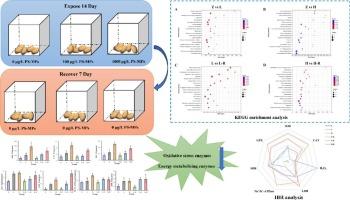The plastic threat to marine gastropods: Oxidative stress, energy metabolism and impaired recovery in juvenile abalone (Haliotis discus hannai) exposed to polystyrene microplastics
IF 4.3
3区 环境科学与生态学
Q2 BIOCHEMISTRY & MOLECULAR BIOLOGY
Comparative Biochemistry and Physiology C-toxicology & Pharmacology
Pub Date : 2025-09-19
DOI:10.1016/j.cbpc.2025.110361
引用次数: 0
Abstract
Microplastic (MP) pollution challenges marine ecosystems, with gastropods like Haliotis discus hannai being potentially vulnerable. However, the reversibility of MP-induced physiological damage in gastropods remains poorly understood. This study investigated the effects of polystyrene microplastics (PS-MPs; 0, 100, and 1000 μg/L) on H. discus hannai in a 14-day exposure followed by a 7-day recovery experimental design. The analysis focused on antioxidant status, energy metabolism, and immune pathways. Results showed dose-dependent oxidative stress during PS-MPs exposure, indicated by significantly (P < 0.05) elevated antioxidant enzyme activities (Superoxide dismutase, Catalase and Glutathione peroxidase), which decreased but did not normalize during recovery. Exposure to a low concentration of PS-MPs (100 μg/L) resulted in metabolic adjustments consistent with homeostatic maintenance, whereas a high concentration (1000 μg/L) significantly increased lactate dehydrogenase and Na+/K+-ATPase activities, suggesting metabolic disruption. These energy metabolism alterations persisted, showing incomplete recovery. Immune pathway analysis revealed minimal changes at low PS-MPs concentrations but significant enrichment of pathways like IL-17 and Fc-Epsilon-RI signaling at high concentrations during exposure. Notably, sustained activation of immune pathways, including NOD-like receptor, Toll-like receptor, and IL-17 signaling (particularly in the high-concentration group), persisted during recovery, potentially indicating prolonged cellular stress or links to apoptosis. Furthermore, Integrated Biomarker Response (IBR) analysis confirmed that H. discus hannai remained severely impacted even after the recovery period. This study provides crucial evidence on the complex toxicodynamics of PS-MPs in H. discus hannai, highlighting incomplete physiological recovery and significant damage during the recovery period following exposure, especially at high concentrations.

塑料对海洋腹足类动物的威胁:暴露于聚苯乙烯微塑料的幼鲍鱼(Haliotis discus hannai)的氧化应激、能量代谢和恢复受损
微塑料污染对海洋生态系统构成了挑战,像盘藻这样的腹足类动物可能很脆弱。然而,mp诱导的腹足类生理损伤的可逆性仍然知之甚少。本研究研究了聚苯乙烯微塑料(PS-MPs; 0、100和1000 μg/L)在14天的暴露下对虹桃的影响,然后进行了7天的恢复实验设计。分析的重点是抗氧化状态、能量代谢和免疫途径。结果显示,PS-MPs暴露期间存在剂量依赖性氧化应激,表现为抗氧化酶(超氧化物歧化酶、过氧化氢酶和谷胱甘肽过氧化物酶)活性显著(P < 0.05)升高,恢复期间活性下降但未恢复正常。暴露于低浓度PS-MPs (100 μg/L)下导致代谢调节符合稳态维持,而高浓度PS-MPs (1000 μg/L)显著增加乳酸脱氢酶和Na+/K+- atp酶活性,提示代谢紊乱。这些能量代谢改变持续存在,表现为不完全恢复。免疫途径分析显示,低PS-MPs浓度下的变化很小,但高浓度暴露时IL-17和Fc-Epsilon-RI信号通路显著富集。值得注意的是,免疫通路的持续激活,包括nod样受体、toll样受体和IL-17信号传导(特别是在高浓度组),在恢复过程中持续存在,可能表明细胞应激延长或与凋亡有关。此外,综合生物标志物反应(IBR)分析证实,即使在恢复期后,铁饼猴仍然受到严重影响。本研究提供了重要的证据,证明了pps - mps在铁饼鱼体内的复杂毒理学,强调了暴露后的不完全生理恢复和恢复期的显著损害,特别是在高浓度下。
本文章由计算机程序翻译,如有差异,请以英文原文为准。
求助全文
约1分钟内获得全文
求助全文
来源期刊
CiteScore
7.50
自引率
5.10%
发文量
206
审稿时长
30 days
期刊介绍:
Part C: Toxicology and Pharmacology. This journal is concerned with chemical and drug action at different levels of organization, biotransformation of xenobiotics, mechanisms of toxicity, including reactive oxygen species and carcinogenesis, endocrine disruptors, natural products chemistry, and signal transduction with a molecular approach to these fields.

 求助内容:
求助内容: 应助结果提醒方式:
应助结果提醒方式:


